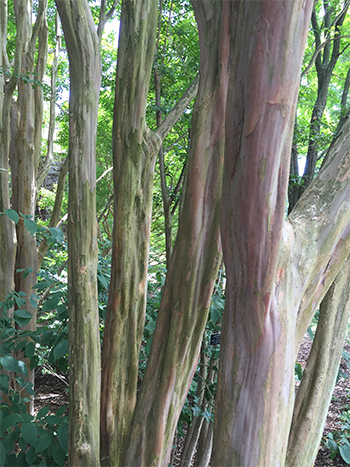July 18: Plant of the Week
Lagerstroemia ‘Natchez’ Hybrid Crapemyrtle
Lagerstroemia ‘Natchez’ is a hybrid crapemyrtle that grows along the path from the McCabe Library to Mertz Hall. Its parent plants are L. faurieri, a specimen that was first collected in a mountain forest of Kurio, Yakushima, Japan, and L. indica ‘Pink Lace.’ This particular cultivar can be identified by its flaking bark that varies from a pale tan to reddish brown hue. It lives about 34 years, grows to 30 feet tall, and is an interesting addition to the garden. In fall, the leaves change to a yellow to reddish yellow. If planted in full sun, the shrub produces white flowers in late summer and early fall. Since its release in 1978, Lagerstroemia ‘Natchez’ has been most commonly planted in the southern United States. Photo credit: Ellen Xie
Metasequoia glyptostroboides ‘Ogon’
This conifer lives in the middle of Parrish Lawn. Bright yellow, and almost fluorescent, its foliage stands out against the more muted greens of its surroundings. Strangely enough, seedlings of the Metasequoia glyptostroboides ‘Ogon’ were first selected from a bath of X-ray irradiated seedlings at the New Oji Paper Company in Japan. Since then, it has traveled from its original home to Europe and North America. The tree can grow to 20 feet in ten years, eventually reaching 70-100 feet. Best grown in full sun, it is tolerant of deer, clay soil, moisture, and air pollution. It requires little maintenance after planting. Photo Credit: Ellen Xie
Pycnanthemum incanum ‘Stowe Away’
Found growing behind the Wister Center, Pycnanthemum incanum ‘Stowe Away’ is a type of mountain mint. Growing in a cluster of 3-foot stems, the tall herbaceous plant is noticeably silver. Step closer and you will find small, white to lavender flowers at the tips. The mint, like all others in its family, releases a fresh scent when crushed. Its distinct aroma keeps deer and many other pests away, while the flowers attract pollinators. It is a species native to Canada, and can be found along the East Coast of the United States. It grows along the edges of woodlands, dry open woods, thickets, pastures, savannas, hillsides, and old fields. Photo Credit: Ellen Xie








No Comments